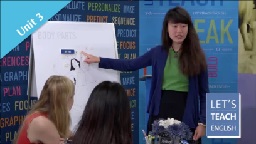|
|
| |
|
|
| |
|
|
|
|
| |
 Let's
Teach English Unit 3 Let's
Teach English Unit 3
The Let’s Teach English video series offers free online
training for English language educators worldwide. It is
based on the Women Teaching Women English text for
adult, beginning level learners. Voice of America and
the University of Oregon are partners on this project. |
|
|
|
Click to see the full PDF lesson -
opens in a new window. |
|
 Unit
3: Speaking Skills and Pronunciation Unit
3: Speaking Skills and Pronunciation
In this lesson, the teacher helps students to overcome
specific pronunciation problems. We join the class near
the beginning of the unit, as they are talking about
photos of different women. They have learned the new
words in a previous class.
The teacher uses the learning strategy personalize. This
strategy helps learners to relate new concepts to their
own experiences. Students personalize as they identify
their individual pronunciation challenges. The teacher
offers methods to help them correctly pronounce their
problem sounds. |
Teacher Preparation Video
This episode shows a model of teaching pronunciation. |
|
 Video Transcript Video Transcript
Narrator: This lesson focuses on helping students to overcome specific
pronunciation challenges. We join the class near the beginning of the unit,
as they are talking about photos of different women. They have heard the
new words in a previous class. |
|
|
Teacher: Good morning, class.
Students: Good morning!
Teacher: Let’s look at these pictures of women.
(The teacher points to four pictures of women.)
Teacher: Which one is most like you? Turn to your neighbor and tell her
which one
and why.
(Students discuss which woman they most look like.)
Teacher: Okay, Jamie, what about you?
Jamie: That one's like me.
(Jaime points to a picture.)
Jamie: She is young and has straight hair. Me too.
Teacher: Thank you. Jamie is personalizing.
(The teacher points to the word “personalize.”)
Teacher: That means thinking about yourself or your own experience. How does
this help you learn English?
Maryam: Because I know myself.
Emma: Because I’m important?
Teacher: Yes. To yourself, you are the most important person in the world.
(The teacher laughs with the class.)
Teacher: But really, that helps us remember things, doesn’t it? When
something is
about us, we care more and we remember it better. In today’s class let’s
practice personalizing. Let’s review the words for this lesson with a game.
(The teacher picks up a basket of words.)
Teacher: Who wants to start?
Emma: I do.
Teacher: Great, Emma. Please come up.
(Emma comes up.)
Teacher: Point to a body part. Then choose someone to show us the word.
Emma: (Emma points to an arm on a large poster of a woman.)
Maryam?
Maryam: Arm?
(Maryam comes up and takes the word “arm” from the basket and puts it
on the poster. Next she points to an eye and calls on Mimi.)
Maryam: Mimi?
Mimi: Eye?
(Mimi comes up and puts the word “eye” on the poster. Next she points to
an eyebrow and calls on Julia.)
Mimi: Julia?
Julia: I don’t know.
Mimi: Can anyone help her out?
Maryam: Eyebrow?
Mimi: Yeah.
Teacher: Okay, good. Now let’s practice saying the words . . . Eye.
(Students repeat each word as the teacher points to it.)
Students: Eye.
Teacher: Eyebrow.
Students: Eyebrow.
Teacher: Nose.
Students: Nose.
Teacher: Lips.
Students: Lips.
Teacher: Okay, now let’s talk about difficult sounds. Look at the words
here.
(The teacher points to the words on the poster.)
Teacher: Which ones are difficult for you?
Maryam: For this word . . .
(Maryam points to her lips).
Maryam: I say /libz/. Is it right?
Teacher: It’s close.
(The teacher points to the letter “p” in the word “lips” on the poster.)
Teacher: Is this the problem?
Maryam: Yes.
Teacher: I have an idea.
(The teacher holds a feather in her hand.)
Teacher: Hold this in your hand. Say "buh."
Students: Buh.
(The teacher and students repeat “buh” several times.)
Maryam: It didn’t move.
Teacher: Yes. Now, make the "puh" sound so air comes out of your mouth.
Students: Puh.
(The feathers blow away. Everyone laughs.)
Julia: It moves!
Jamie: That’s cool! Lips.
(Jamie’s feather blows away as she says the word “lips.”)
Teacher: Okay! Now, hold your hand here.
Teacher: Say “buh.”
Students: Buh.
Teacher: Buh.
Students: Buh.
Teacher: Do you feel that?
Julia: It moves.
Teacher: Yes! Now say "puh, puh." What do you feel?
Mimi: Puh. It’s different.
Teacher: That’s good. We are personalizing. Try to remember this when you
say
other words with "puh." Now, are there any other difficult sounds?
Narrator: Summary: The teacher uses the learning strategy personalize. This
strategy helps learners to relate new concepts to their own experiences.
Students personalize as they identify their individual pronunciation
challenges. The teacher offers methods to help them correctly pronounce
their problem sounds. Next time, join us for Unit 4. We will teach reading
skills. |
|
Transcript Vocabulary
identify (verb) – to find out who someone is or what something is
overcome (verb) – to successfully deal with or gain control of (something
difficult)
personalize (verb) – to change or design (something) for a particular person
specific (adjective) – special or particular
© 2017 University of Oregon and Voice of America. This work is based on the
Women Teaching Women English materials
produced by the University of Oregon American English Institute under U.S.
Department of State Federal Assistance Award
S-LE200-10-GR-050, issued by the U.S. Embassy Beirut. |
|
|
|
|
|
|
|
|
|
|
|
|
Grammar Tips |
Can You Catch These Native Speaker Mistakes?
(Beginner - Listening)
An audio lesson to
help with your understanding of common mistakes. The English is
spoken at 75% of normal speed.
Click here to visit the lesson page with the written script for this
audio program. |
Commonly Confused Words: Part One
(Beginner - Listening,
reading)
A video lesson to
help with your understanding of commonly confused
words.
The English is
spoken at 75% of normal speed.
Click here to visit the lesson page. |
Commonly Confused Words: Part One
(Beginner - Listening)
An audio lesson to
help with your understanding of commonly confused
words. The English is
spoken at 75% of normal speed.
Click here to visit the lesson page with the written script for this
audio program. |
Commonly Confused Words: Part Two
(Beginner - Listening,
reading)
A video lesson to
help with your understanding of commonly confused
words.
The English is
spoken at 75% of normal speed.
Click here to visit the lesson page. |
Commonly Confused Words: Part Two
(Beginner - Listening)
An audio lesson to
help with your understanding of commonly confused
words. The English is
spoken at 75% of normal speed.
Click here to visit the lesson page with the written script for this
audio program. |
|
|
|
|
Search Fun Easy English |
|
|
|
|
|
|
|
|
|
|
|
|
|
|
|
About
Contact
Copyright
Resources
Site Map |